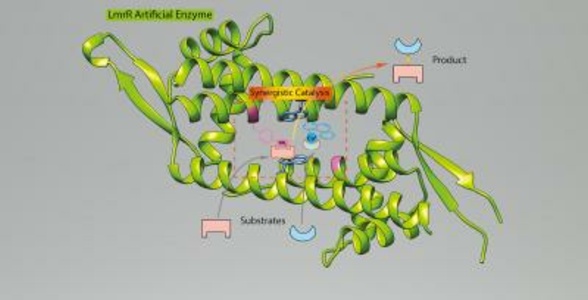Scientists have used an unnatural amino acid and a catalytic copper complex to create a new, artificial enzyme.
Enzymes are natural catalysts that operate under mild conditions. This makes them an attractive alternative for industrial chemical catalysis, which may require high temperature and pressure and toxic solvents or metals. However, not all chemical reactions can be catalyzed by natural enzymes. Modifying existing enzymes is one option but University of Groningen Chemistry Professor Gerard Roelfes believes that creating new enzymes could be another valuable option.
For this study, they added a copper complex to a protein that had no enzymatic properties and inserted an unnatural amino acid into the protein. Together with the copper, a side chain of the amino acid was able to catalyze the required reaction. This technique could replace standard chemical catalysis and make chemistry more energy-efficient and therefore cleaner.

"Natural enzymes evolved to catalyse specific reactions. Adapting requires a kind of devolving of the enzyme. That is why we pioneered the creation of new, unnatural enzymes," Roelfes says. In 2018, they created a non-enzymatic protein, the bacterial transcription factor LmrR, which could form non-biological hydrazone structures after the insertion of the unnatural amino acid p aminophenylalanine. This was the first enzyme created using an unnatural amino acid as a catalytic group.
This time, they used the same LmrR protein and added two abiological catalytic components to it: one was the same unnatural amino acid p aminophenylalanine and the other a copper-containing complex. Both can activate the reaction partners for the classic Michael addition reaction, which is widely used in organic chemistry to create carbon-carbon bonds. "But they both have to be in the right position to efficiently and selectively catalyse this reaction,' says Roelfes. "Just adding both components to a test tube would not work: 'In fact, they cancel each other out when they come too close."
The copper-containing complex attaches itself to the doughnut-shaped LmrR protein through supramolecular bonds. Its position is determined by the interaction with the protein. They determined where the p-aminophenylalanine should be inserted into the protein to create an active site. The catalytic part of this amino acid is an aniline side chain. They knew the potential utility of this aniline side chain for catalysis and envisioned that it would be possible to combine it with copper catalysis. When the novel enzyme was constructed, the adapted protein turned out to be a very selective catalyst for the Michael addition.